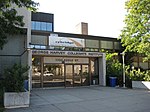Union Pearson Express

The Union Pearson Express (UP Express or UPX) is an airport rail link connecting Union Station in Downtown Toronto to Toronto Pearson International Airport. The UP Express began operation on 6 June 2015, in time for the 2015 Pan American Games. The UP Express travels between Union and Pearson in 25 minutes departing every 15 minutes, seven days a week. At the launch announcement, it was stated that the UP Express was projected to carry 2.35 million passengers annually and eliminate approximately 1.2 million car trips in the first year.UP Express is operated as an independent division of Metrolinx, similarly to GO Transit. An airport rail link was one of the priority projects identified in Metrolinx's regional transportation plan, "The Big Move". Construction began in 2011 as part of the Georgetown South Project, which expanded the rail corridor the UP Express shares with GO Transit and Via Rail. UP Express uses diesel multiple unit (DMU) trains that meet United States Environmental Protection Agency Tier 4 emission standards. The Kitchener line and UP Express will be electrified, although no date has been set. The UP Express has been criticized for not using electric trains from the outset, and for its initial fare prices that were high compared with other North American airport–city connections.
Excerpt from the Wikipedia article Union Pearson Express (License: CC BY-SA 3.0, Authors, Images).Union Pearson Express
Weston Road, Toronto York
Geographical coordinates (GPS) Address Nearby Places Show on map
Geographical coordinates (GPS)
| Latitude | Longitude |
|---|---|
| N 43.677 ° | E -79.47 ° |
Address
Custom Kitchen
Weston Road
M6N Toronto, York
Ontario, Canada
Open on Google Maps








